Up here in the Great Lakes region, spring arrives, at least according to the calendar, on March 20 this year. More specifically, the vernal equinox arrives (autumnal to those of you in the Southern Hemisphere). Few people today care about this celestial event, but ancient people cared very deeply, so deeply they traced the exact moment it happened by marking it in stone.
You can follow it too. All you need to do is look at the rising run each day from a fixed point. Note where the sun rises. If there is a building in the way, note where the sun rises in relation to the building. If it’s a hill or a tree, note that position. As the days go by, you’ll see the spot where the sun rises change. If you keep track, you’ll see the rising sun location follows a certain path along the eastern horizon. Then one day you’ll see the rising sun stop its forward motion. That moment when the sun seems to stop and change direction is a solstice (sol = sun, stice = stop), a sun-stop.
If you keep following the sunrises, you’ll see a progression back along the same path on the horizon until it once again seems to stop. That’s the other solstice.
If you followed the sunsets each of these days, you’d find an equal swing from north to south and back again. Burlington, Vermont erected an “Earth Clock,” a modern answer to the ancient circles of stones. They’ve even provided blueprints for other communities that would like to build their own “henge.” The University of Massachusetts created a “Sunwheel” that marks the solstices, equinoxes, and moon cycles (diagram).
While the far points mark the solstices, the mid-points in these swings are the equinoxes (equi =same, nox = night), where the length of the day and night are the same. In the northern hemisphere, we will have the spring equinox around March 21, the summer solstice around June 21, the fall equinox around September 22, and the winter solstice around December 21.
Many ancient structur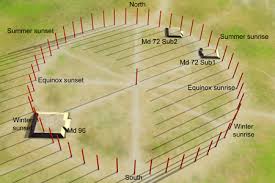 es celebrate exactly this cycle. Stonehenge and many other circles of standing stones or wooden posts, like the woodhenge at Cahokia Mounds in the photo, are aligned to mark the solstice points.
es celebrate exactly this cycle. Stonehenge and many other circles of standing stones or wooden posts, like the woodhenge at Cahokia Mounds in the photo, are aligned to mark the solstice points.
The Maya E-group, a common architectural feature in Lowland Maya sites, is believed to mark both the solstice points and the equinoxes (See diagram).
Unlike modern people, who see the celestial events as mechanical, predictable, and fairly unimportant, ancient people saw them as terribly important parts of their lives. The changes in the heavens caused the changes on earth: the end of winter, the coming of spring, the rebirth of nature. But without human help, the motion of the heavens could cease or change, causing ruin and death for all the beings on earth. Important changes, such as the solstices and equinoxes, required recognition and participation, often in the form of rituals and sacrifice.
While we don’t usually sacrifice humans or animals to ensure the change of the season anymore, we often engage in ritual behavior associated with important holidays that fall on or near the solstices and equinox.
Vernal Equinox – in North America, March 20, 2014
During the vernal equinox, the sun shines directly on the Equator, and the day and night are equal length (12 hours each). It falls on the mid-point of the swing between the equinoxes.
The Vernal Equinox marks the beginning of the New Year in many cultures. Traditionally, spring is associated with rebirth and fertility, often symbolized by the egg and the rabbit. Modern versions include the Easter Bunny, which (curiously) lays eggs and leaves candy for children.
The Maya pyramid called El Castillo at Chichen Itza (photo) is famous for the Snake of Sunlight that courses along the stairway on the Vernal Equinox. Excellent videos of the event are available on YouTube. Scholars have debated why it was so important for the Maya and other ancient people to mark this moment – to celebrate it in their monuments.
Some say the people needed to know when to plant and harvest, but they would have known that from many signs, just as you would know the change of season fro m your immediate environment. Around here, you could see skunk cabbage pushing up through the last snow, red-wing blackbirds returning, hear wood frogs singing. Your dirt road would turn into a mass of ice and mud. Your dog would shed. You wouldn’t need a stone monument to tell you spring was happening. But if you believed that you needed to help spring arrive, a large, impressive monument would be very important as a focal point for the ritual of bringing in the change.
m your immediate environment. Around here, you could see skunk cabbage pushing up through the last snow, red-wing blackbirds returning, hear wood frogs singing. Your dirt road would turn into a mass of ice and mud. Your dog would shed. You wouldn’t need a stone monument to tell you spring was happening. But if you believed that you needed to help spring arrive, a large, impressive monument would be very important as a focal point for the ritual of bringing in the change.
Easter, the Christian feast celebrating the triumph of Jesus Christ over death, falls on a date determined by the Vernal Equinox, specifically the first Sunday after the first full moon after the Vernal Equinox.
The Summer Solstice in North America, June 21, 2014
The June Solstice is one of the two sun-stops in the path of the sunrises (and sunsets). In the Northern Hemisphere, it marks the longest day of the year; in the Southern Hemisphere, the shortest. Festivals in Scandinavia celebrate the day of endless light, the Midnight Sun. Ancient Germanic, Celtic, and Slavic people celebrated with wild parties and bonfires. In ancient China, it was the festival of the Earth and female/yin forces. For the ancient Greeks, it marked the first day of the year.
The Medicine Wheel (photo), set high on a mountain in Wyoming, is designed to mark the Summer Solstice. Built around 1200, it is still considered a sacred site by American Indians in the area. The photo shows the sunset on the longest day of the year. Many researchers feel this was one of several installations in the area, each of which marked one particular moment in the turning of the year.
Stonehenge, the great circle of standing stones in England, has become a popular gathering place for people celebrating the Summer Solstice, though the site may have had many purposes, including honoring the dead during the Winter Solstice. Over sixty cremated remains were discovered inside the inner circle. The giant stone trilithon frames the Midwinter solstice sunset.
However, the revelers are not wrong in choosing this spot to mark the June solstice. Archaeologist Parker Pearson, who has been working at the site, pointed out the avenue, discovered in 2008, that leads out of Stonehenge, built over a natural rock ledge. Next to this ledge, pits were dug 10,000 years ago to hold a line of posts. This feature, at least 4,000 years older than the familiar circle of giant stones, points directly to the spot where the sun rises on the midsummer solstice.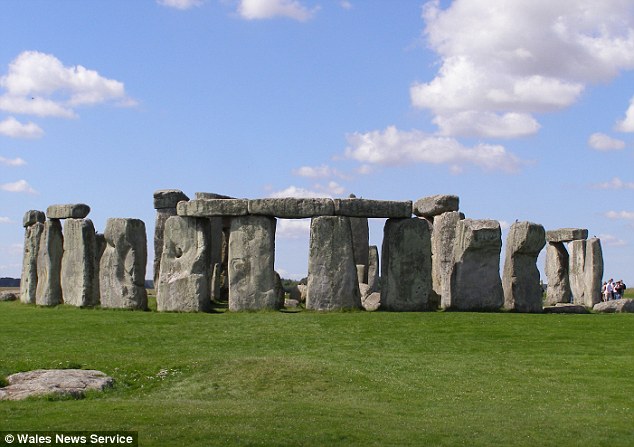
Celebrations at Stonehenge may also have been musical affairs. The bluestone used to construct the famous henge makes loud and varied sounds, like gongs, bells, and drums, when struck, an early rock concert, if you will. Some researchers believe these sonic qualities were one of the reasons ancient people dragged the giant stones 200 miles from Wales to Stonehenge. Researchers say the sounds could have been heard half a mile away.
Autumnal Equinox in North America, September 22, 2014
The September Equinox falls at the same midpoint as the April Equinox – the halfway point in the sun’s path across the horizon at the moment it rises. Like the Vernal (spring) Equinox, the day and night are the same length.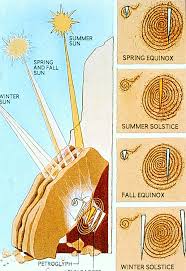
The famous Sun Dagger on Fajada Butte in Chaco Canyon, New Mexico, built at least 1000 years ago, provided a different way to mark the solstices and equinoxes. In 1977, an artist recording rock art in the area noticed three rock slabs leaning against a cliff. Whether they were placed exactly there or someone noticed them there is not known. But researchers soon realized that the spirals carved on the cliff face were very carefully placed to take advantage of the shafts of light falling between the stones. At the summer solstice, sunlight passing between the rock slabs would fall directly across the center of the larger spiral. During the Equinoxes, the dagger would fall between the center of the spiral and the edge. At the Winter Solstice, two daggers would appear, one on each edge of the large spiral. Unfortunately, visitors to the site caused some damage and the site is now closed to the public.
Harvest festivals are common around the Equinox.
The Winter Solstice, December 21, 2014
By far the most dangerous of the events in the sun cycle was the shortest day of the year, a time when darkness far outweighed light. Ancient people feared the light would not return. To ensure it did, they kept careful vigil, especially on the night of the winter solstice and the following day. The passage tomb at Newgrange, Ireland, built more than 5,000 years ago, features a special roofbox opening that allows light to shine along the inner passage at sunrise on morning of the Winter Solstice. The light illuminates a stone basin below intricate carved spirals, eye shapes, and disks. The photo shows how the site looked in 1905. It’s now a very popular tourist site.
Maeshowe, on the Orkney Islands in the north of Scotland, has a roofbox that admits a shaft of light from the Winter Solstice setting sun.
The Great Zimbabwe complex in sub-Saharan Africa may have served a similar purpose. Other sites in the Americas, Asia, Indonesia, and the Middle East may have also marked this important day. In Iran, people observed Yalda by keeping vigil through the night and burning fires to help the sun battle the darkness.
We still want to light up the darkness, even if we’ve forgotten about the solstice. We still celebrate the passing of the sun on its yearly course, but those celebrations are now submerged into our holidays: Easter, Christmas, Halloween, even Groundhog Day. Because Groundhog Day falls halfway between the Winter Solstice and the Vernal Equinox, we’ll always have six more weeks of winter, but the groundhog gives us a reason to party.
Happy Vernal Equinox!
Sources and interesting reading:
“Chart of 2014 equinox, solstice and cross quarter dates and times,” archaeoastronomy.com, http://www.archaeoastronomy.com/2014.html
“Chichen Itza Pyramid, the descent of the feathered serpent” (video) YouTube
“Customs and Holidays around the March Equinox” timeanddate.com, tyyp://wwwtimeanddate.com/calendar/march-equinox-traditions.html
“EarthClock measures hours, months, solstices and equinoxes,” Freethought Nation, July 29, 2011, http://freethoughtnation.com/earth-clock-measures-hours…
“Fajada Butte,” Wikipedia, http://en.wikipedia.org/wiki/Fajada_Butte
Griffiths, Sarah, and Amanda Williams, “Stonehenge was a prehistoric centre for rock music: Stones sound like bells, drums, and gongs when played,” Mail Online, Daily Mail (UK), http://www.dailymail.co.uk/sciencetech/article-2515159/Why-Stonehenge-prehistoric-cent…
Hirst, K.Kris. “E-Group: Ancient Maya Building Complex,” About.com Archaeology, http://archaeology.about.com/od/mayaarchaeology/qt/E-Group.htm
“Huge Settlement Unearthed at Stonehenge Complex,” Science Daily, http://sciencedaily.com/releases/2007/01/070130191755.htm
“June Solstice’s Influence Across Cultures and Ages,” timeanddate.com, http://www.timeanddate/com/calendar/june-solstice-customs.html
“March Equinox: March 20, 2014,” timeanddate.com, http://www.timeanddate.comcalendar/march-equinox.html
A reader suggested http://www.thetimenow.com/ as a better source.
“Newgrange,” Wikipedia http://ed.wikipedia.org/wiki/Newgrange
Odenwalk, Dr. Sten, “Ancient Astronomical Alignments,” Sun-Earth Day 2010: Ancient Mysteries, Future Discoveries, NASA, Godard Space Flight Center, http://sunearthday.nasa.gov/2011/articles
“Rock Art and Ancient Solar Energy,” Stanford Solar Center, http://solar-center.stanford.edu/folklore/rockart.html
“September Equinox Customs and Holidays,” timeanddate.com, http://www.timeanddate.com/calendar/september-equinox-customs.html\
“Stonehenge Revealed: Why Stones Were a ‘Special Place’” National Geographic Daily News, http://news.nationalgeographic.com/news/2013/13/130621
“Summer Solstice Traditions, History.com, June 18, 2013, http://www.history.com/news/history-lists/summer-solstice-traditions
“Winter Solstice – December 21,” http:www.crystalinks.com/wintersolstice.html
Young, Dr. Judith S., Department of Astronomy, University of Massachusetts, Amherst, “Moon teachings for the masses at the UMass Sunwheel and around the world: the major lunar standstills of 2006 and 2014-25,” http://www.umass.edu/sunwheel/pages/moonteaching.html


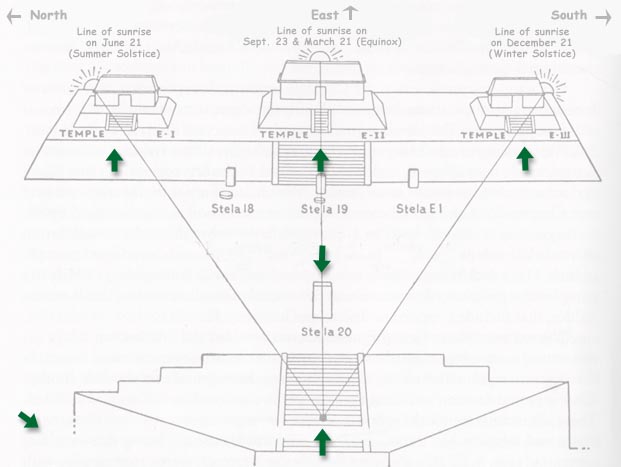
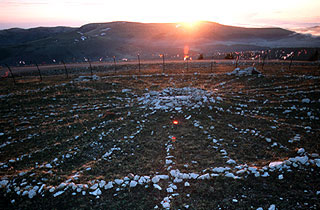
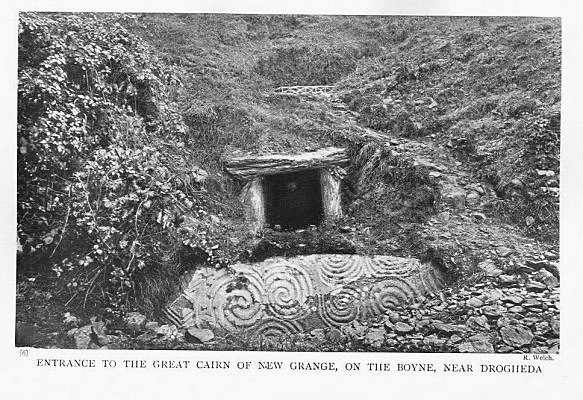
I recently read that reconsidering the buildings at Petra, Jordan shows that they too are built around astronomical principles highlighting the key days in the year.
Interesting! Many Inca and pre-Inca sites should be included too.
Pingback: Solstice and Santa | misfitsandheroes
Reblogged this on Die Goldene Landschaft.